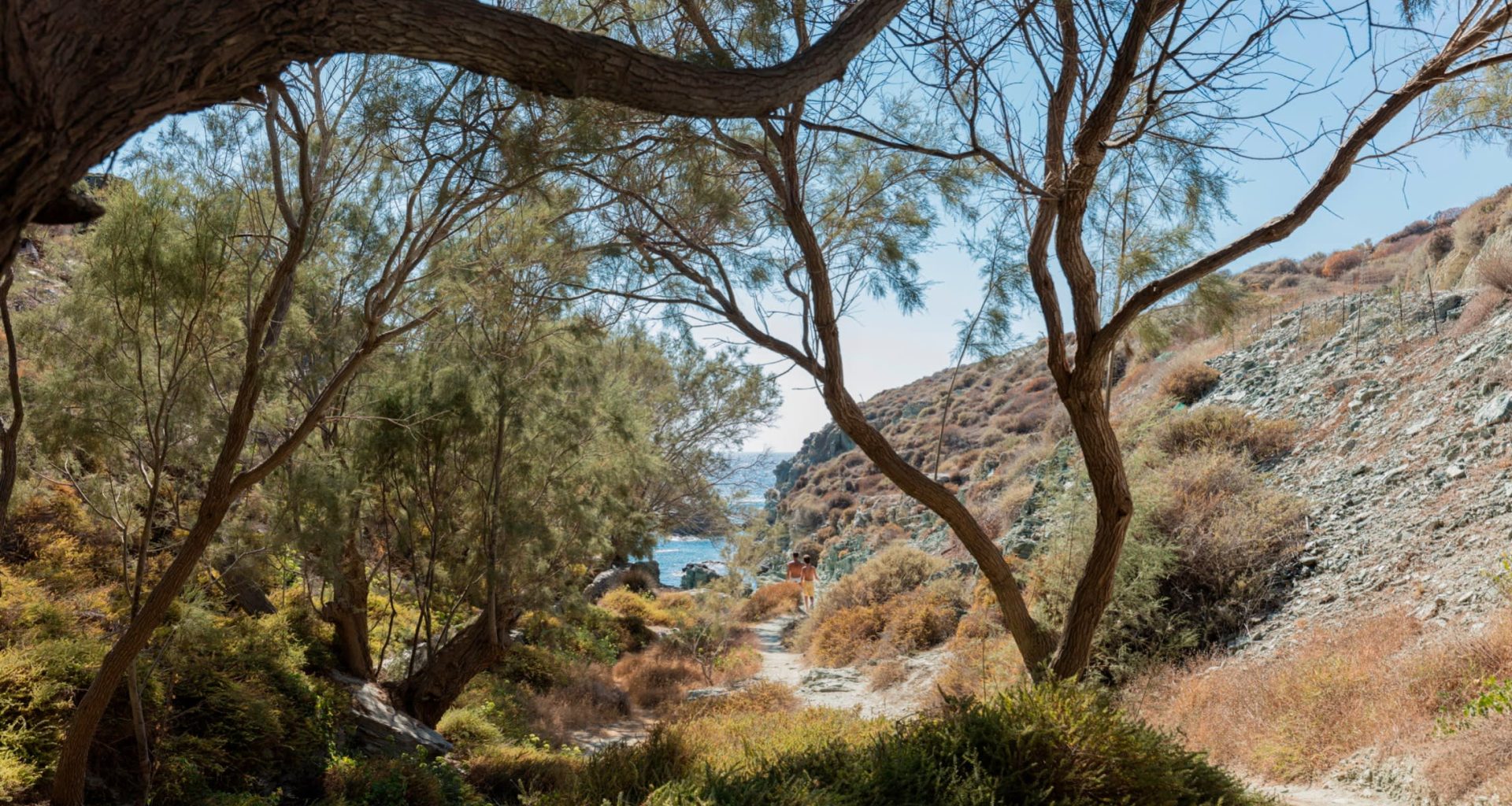At first, all you see is a pyramid of rock plunging into a sea of fluorescent blue. A wisp of cloud hovers above the pinnacle. As your eyes adjust to the harsh light and harsh landscape, a thin white line appears like a mirage, etched into the rim of the cliff.
This is the Chora of Folegandros, one of the most beautiful villages I have ever seen. Built on the brink of a precipice to protect the inhabitants from the pirates who once plagued the Aegean, the village is a puzzle of alleys radiating from three interlocking squares. The oldest part of town is the medieval Kastro: a fortified huddle of cottages with tiers of whitewashed stoops, brightly painted shutters, and hidden balconies dangling between sea and sky. For idlers and escapists, it is the definition of living on the edge.
Folegandros, one of the smallest inhabited islands in the Cyclades, is on the edge in other ways. In April 2024, Folegandros and the nearby islands of Sifnos and Serifos were declared one of the seven most endangered sites in Europe by Europa Nostra, a pan-European federation of NGOs that campaigns to protect heritage sites.
“These islands still preserve most of their traditional features and characteristics but are confronted with a sudden and serious increase of tourism and the building of vacation homes of significant scale,” says Stathis Potamitis, the president of Elliniki Etairia, the non-profit organisation that masterminded the Europa Nostra campaign. “Our aim is to make sure that measures to avoid the perils of overtourism are taken well in advance of the degradations that uncontrolled development may bring.”


Isolated and arid, Folegandros has roughly 700 inhabitants, but only about half of them live on the island year-round. Most of the residents live in Chora or around Ano Meria, a rural settlement where shepherds and farmers eke a living from sheer slopes terraced with dry stone walls. Known as louriá (reins) or skáles (steps), these walls are a primitive but ingenious way of preserving water and preventing soil erosion. Winds can be so fierce that every precious lemon tree is protected by a ring of stones, which grows taller with the tree.
Among the squat farmhouses, called themoniés, where this traditional way of life has barely changed for generations, modern villas for sale and rent are springing up. Hunkered in one hillside, the Mexican artist Bosco Sodi has built an estate from local green limestone and slabs of concrete. Like Sodi’s artworks, the buildings are an exploration of naturally weathered materials; but not all the ongoing construction on Folegandros is as subtle or as sensitive to local conditions and constraints.

So, I have come to the island with a mixture of excitement and apprehension to stay at Gundari, a new resort with big ambitions. With 25 suites and two villas (and another 14 suites and a hydrotherapy spa in the pipeline), Gundari is smaller than Anemi, the island’s only other five-star hotel, which has 44 rooms and claims to offer “baffling vistas” of the modest port, Karavostasi.
At Gundari, the views can only be described in hyphenated clichés: jaw-dropping, mind-blowing, awe-inspiring. Hidden at the end of a dirt road, surrounded by 80 acres of raw wilderness and a blank horizon of endless blues, Gundari is as well-camouflaged from a distance as Chora.
The boxy, bioclimatic buildings are barely even visible from the sea. All the rooms have private pools; in the “cave suites”, burrowed from the reddish rock, the infinity pools seem to float above the Aegean. If the brown-and-beige interiors feel rather bland, perhaps that’s a good thing: nothing diverts attention from the phenomenal setting.


Gundari is still a work in progress when I arrive in May. The unfailingly charming staff are working flat out to perfect the landscaping and to refine the elegant dishes in Orizon restaurant, with a menu by the big daddy of Greek fine dining, Lefteris Lazarou. Doing everything, everywhere, all at once is a burly figure with unruly curls, a broad smile, and clear blue eyes full of mischief. Ricardo Larriera, the Australian owner of Gundari, is clearly invested in this project in a very personal way.
An advertising executive, Larriera had never heard of Folegandros when a Greek-Australian friend proposed that they partner up to buy a small, abandoned hotel overlooking the pebbly port beach, Chochlidia. Larriera came to check it out, fell madly in love with Folegandros, and dreamt up a way more out-there resort that would make a virtue of the island’s wild side. (Next summer, that modest hotel on Chochlidia will become a beachfront restaurant and staff quarters for Gundari.)
“I had the naïveté to think it would be easy to build a hotel on a remote Greek island,” Larriera tells me. “I imagined myself lying by the pool drinking cocktails, not chasing plumbers and lugging rubble.”
With a sunken swim-up bar, the solar-heated swimming pool is testament to Larriera’s original vision. He has introduced all sorts of joyful, thoughtful details that no number-crunching hotel chain would ever greenlight: a vinyl library, a fleet of electric Mini Mokes, Fiat 500s, and mountain bikes, and two streamlined speedboats for coastal adventures and high-speed transfers from Santorini (about an hour away). Next year, an old themoniá on the grounds will become an intimate wine bar, while the surrounding patchwork of plots will be replanted for farm-to-fork dining in the fields.



Coaxing drought-resistant plants out of this wind-worn landscape will not be easy. Larriera has enlisted the help of an unlikely double act: the vice-mayor Dimitris Sideris, an organic cheesemaker, farmer and restaurateur, and Ben Johnson, a former undercover cop from Arizona turned regenerative farmer.
Silver-haired and self-contained, Sideris has the lean physique of a much younger man. He has just finished making a fresh batch of fluffy, white sourotó — the local cheese that elevates Greek salads to another level — when Larriera and I show up at his smallholding in the Livadi valley. Behind him, wheels of goat’s cheese are maturing on planks, waiting to be served with his wife’s raisin chutney at Chic, their enchanting restaurant in Chora.
“I don’t do this for profit,” says Sideris, wrapping up a whole cheese to give me. “I do it for love.” Sideris grows grain to feed his goats and sheep, bakes his own bread, and grows vegetables, herbs and olives for the restaurant. Producing your own ingredients makes sense as supplies are difficult and costly to get to Folegandros; refrigerated trucks arrive only a few times per week on the eight-hour ferry from Athens.
Most tourists arrive on the catamaran, which takes about four hours (a disagreeable experience, especially in rough seas, as you cannot go outside). When Sideris was a boy, there was only one boat a week and the journey took 36 hours; so the islanders were completely self-sufficient — aside from a little sugar and coffee — until tourism arrived.



“Tourism is a double-edged sword,” says Johnson, a gentle presence in battered Levi’s and a flat cap. “There’s this very intense period of activity for four months, but it doesn’t ensure that these isolated communities and their ecosystems remain inhabited and alive for the rest of the year. Saving this way of life will also be good for tourism, because if there’s no real local life on the island, no tourists will come.”
Sideris agrees: “We don’t have beaches like Copacabana. What we ‘sell’ is that we are a virgin island, so we need to preserve this raw beauty and virgin character.”
The beaches on Folegandros may not be sandy but they are pure heaven if you like swimming naked, snorkelling through caves of liquid blue light or snoozing under a tamarisk tree serenaded by cicadas. Most of the pebbly coves are only accessible on foot or boat. One of the most spectacular beaches is Katergo, meaning “hard labour”, which gives you an idea of the cliffside scramble required to get there. (In fact, the name derives from the political prisoners who were exiled on the island for decades and forced to break rocks on the beach.) On Folegandros, there are no sunbeds, water sports, or beach bars — unless you count Evangelos, a hippy shack just steps from the ferry dock.



If Karavostasi port has a mellow, end-of-the-line vibe, Chora flickers into action at dusk, when tiny bars like Astarti and Aquarius serve rakomelo (warm grappa with honey) and sunset-chasers wander up the zigzagging steps to Panagia, the island’s landmark church. You can see a dozen islands from here on a clear day. If you go with local guide Poly Gkiouri, she will open the church to reveal a rare marble templon. A cultural anthropologist, Gkiouri is a trove of local lore, like the story behind Danube square, named after Europe’s great river because of its large rainwater-filled cisterns where donkeys and sheep once came to drink.
Everyone has a favourite square in Chora. Mine is Pounta, poised on the cliff edge — partly for the plummeting views, but mostly for the namesake café, which serves the most delicious takos (open sandwiches) on dotty ceramics made by the owner, Lisbet Schou-Giouri. Their tomatoes are grown in upcycled chairs in the back garden, a riot of geraniums and bamboo.
Next door is the tiny HQ of the Cultural Association of Folegandros, whose president turns out to be Alexis Sideris, Dimitris’ wise young son. It’s easy to feel intimately connected to everyone after just a few days on Folegandros. Locals always have time for a chat, from the 80-year-old shepherd milking goats with his grandson, to Irene Psaromilingou, the feisty grandmother who cooks some of the island’s best food at her grocery-tavern in Ano Meria. (Larriera has persuaded Irene to give Gundari’s guests cooking lessons.)

This sense of intimacy is heightened by the island’s human scale. By nature, Folegandros has limited capacity: small beaches, few roads, scarce water. “I think Folegandros has a way of protecting itself,” says Larriera. “The wind, the terrain, the remoteness, the lack of an airport, and the fact that much of the island is classified as forestry land, which you cannot build on.”
With the Greek government threatening to relax zoning laws designed to protect coastal and agricultural land from development, locals are nervous that Gundari might pave the way for bigger, less sensitive hotels in more visible locations. As well as straining the natural resources and infrastructure, that would change the character of the island.
Gundari will certainly attract a different crowd, who are more likely to come by speedboat than on the slow boat from Piraeus, pausing at half a dozen islands en route. All are dramatic and beautiful in their own ways, but none are quite so dramatic or beautiful as this fragile rock, Folegandros.
Details
Rachel Howard was a guest of Gundari (gundari.com) which has double rooms from £550 per night, including breakfast, dropping to £380 at the end of September. Folegandros is about four hours from Athens by fast catamaran (seajets.com), although loading and unloading at other islands en route can often cause delays. Conventional, car-carrying ferries (zanteferries.gr) take seven or eight hours. Seajets also runs a service from Santorini, which has an international airport, taking about an hour
Find out about our latest stories first — follow FTWeekend on Instagram and X, and subscribe to our podcast Life and Art wherever you listen
Read More: World News | Entertainment News | Celeb News
FT







